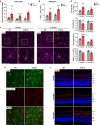Early alterations of neurovascular unit in the retina in mouse models of tauopathy
- PMID: 33762004
- PMCID: PMC7992935
- DOI: 10.1186/s40478-021-01149-y
Early alterations of neurovascular unit in the retina in mouse models of tauopathy
Abstract
The retina, as the only visually accessible tissue in the central nervous system, has attracted significant attention for evaluating it as a biomarker for neurodegenerative diseases. Yet, most of studies focus on characterizing the loss of retinal ganglion cells (RGCs) and degeneration of their axons. There is no integrated analysis addressing temporal alterations of different retinal cells in the neurovascular unit (NVU) in particular retinal vessels. Here we assessed NVU changes in two mouse models of tauopathy, P301S and P301L transgenic mice overexpressing the human tau mutated gene, and evaluated the therapeutic effects of a tau oligomer monoclonal antibody (TOMA). We found that retinal edema and breakdown of blood-retina barrier were observed at the very early stage of tauopathy. Leukocyte adhesion/infiltration, and microglial recruitment/activation were constantly increased in the retinal ganglion cell layer of tau transgenic mice at different ages, while Müller cell gliosis was only detected in relatively older tau mice. Concomitantly, the number and function of RGCs progressively decreased during aging although they were not considerably altered in the very early stage of tauopathy. Moreover, intrinsically photosensitive RGCs appeared more sensitive to tauopathy. Remarkably, TOMA treatment in young tau transgenic mice significantly attenuated vascular leakage, inflammation and RGC loss. Our data provide compelling evidence that abnormal tau accumulation can lead to pathology in the retinal NVU, and vascular alterations occur more manifest and earlier than neurodegeneration in the retina. Oligomeric tau-targeted immunotherapy has the potential to treat tau-induced retinopathies. These data suggest that retinal NVU may serve as a potential biomarker for diagnosis and staging of tauopathy as well as a platform to study the molecular mechanisms of neurodegeneration.
Keywords: Leukocyte adhesion/infiltration; Microglial recruitment/activation; Neurodegeneration; Neurovascular unit; Retina; Tau oligomer monoclonal antibody; Tauopathy; Vascular leakage.
Conflict of interest statement
The authors declare that they have no competing interests.
Figures






Similar articles
-
Longitudinal characterization of retinal vasculature alterations with optical coherence tomography angiography in a mouse model of tauopathy.Exp Eye Res. 2022 Nov;224:109240. doi: 10.1016/j.exer.2022.109240. Epub 2022 Sep 10. Exp Eye Res. 2022. PMID: 36096190 Free PMC article.
-
Evidence for accelerated tauopathy in the retina of transgenic P301S tau mice exposed to repetitive mild traumatic brain injury.Exp Neurol. 2015 Nov;273:168-76. doi: 10.1016/j.expneurol.2015.08.014. Epub 2015 Aug 24. Exp Neurol. 2015. PMID: 26311071
-
Mutant three-repeat tau expression initiates retinal ganglion cell death through Caspase-2.Neurobiol Dis. 2021 May;152:105277. doi: 10.1016/j.nbd.2021.105277. Epub 2021 Jan 29. Neurobiol Dis. 2021. PMID: 33516874 Free PMC article.
-
Review: tauopathy in the retina and optic nerve: does it shadow pathological changes in the brain?Mol Vis. 2012;18:2700-10. Epub 2012 Nov 12. Mol Vis. 2012. PMID: 23170062 Free PMC article. Review.
-
Tau Seeding Mouse Models with Patient Brain-Derived Aggregates.Int J Mol Sci. 2021 Jun 7;22(11):6132. doi: 10.3390/ijms22116132. Int J Mol Sci. 2021. PMID: 34200180 Free PMC article. Review.
Cited by
-
Isolation of microglia from retinas of chronic ocular hypertensive rats.Open Life Sci. 2021 Sep 15;16(1):992-1001. doi: 10.1515/biol-2021-0100. eCollection 2021. Open Life Sci. 2021. PMID: 34604533 Free PMC article.
-
pTau pathology in the retina of TAU58 mice: association with ganglion cell degeneration and implications on seeding and propagation of pTau from human brain lysates.Acta Neuropathol Commun. 2024 Dec 20;12(1):194. doi: 10.1186/s40478-024-01907-8. Acta Neuropathol Commun. 2024. PMID: 39707519 Free PMC article.
-
Non-Invasive Evaluation of Retinal Vascular Alterations in a Mouse Model of Optic Neuritis Using Laser Speckle Flowgraphy and Optical Coherence Tomography Angiography.Cells. 2023 Nov 22;12(23):2685. doi: 10.3390/cells12232685. Cells. 2023. PMID: 38067113 Free PMC article.
-
Dissection of blood-brain barrier dysfunction through CSF PDGFRβ and amyloid, tau, neuroinflammation, and synaptic CSF biomarkers in neurodegenerative disorders.EBioMedicine. 2025 May;115:105694. doi: 10.1016/j.ebiom.2025.105694. Epub 2025 Apr 15. EBioMedicine. 2025. PMID: 40239464 Free PMC article.
-
The Absence of FAIM Leads to a Delay in Dark Adaptation and Hampers Arrestin-1 Translocation upon Light Reception in the Retina.Cells. 2023 Feb 2;12(3):487. doi: 10.3390/cells12030487. Cells. 2023. PMID: 36766830 Free PMC article.
References
Publication types
MeSH terms
Substances
Grants and funding
LinkOut - more resources
Full Text Sources
Other Literature Sources
Molecular Biology Databases

